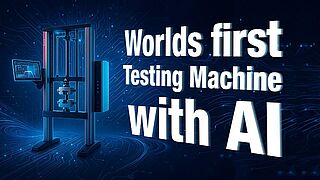The World's First AI-Assisted Tensile Test – Our Vision of Tomorrow's Materials Testing
The future of materials testing does not smell like science fiction, but rather like a workshop, data knowledge and a pinch of courage to innovate. Standards will remain like land marks in the mountains, but the path to them is changing. New technologies, automation and the buzzword-that-is-not-a-buzzword-anymore: Artificial intelligence.
At ZwickRoell, we looked into the proverbial crystal ball and asked ourselves: What could a tensile test look like if AI was not just "there" but a real companion? The result is not a marketing daydream, but a concept that shows what is already possible today. Much is still in experimental mode, some unanswered questions like an unfinished research journal. But that's exactly why we're talking about it. Vision does not come from a quiet little room, but in dialog with those who will work with it.
A machine that listens, thinks and assists
Imagine starting a tensile test not with clicks and parameters, but with a conversation. You chat with AI as if you were chatting with an experienced colleague: “What test are you planning? What is the material? What are the normative requirements? What do you need to consider?"
The AI provides answers, knowledge and recommendations. It explains standard details, suggests test parameters and reminds you of preparations, as if it had a list of the usual errors in mind. When you are ready, give the command: "Please prepare testXpert."
The AI understands the context and automatically sets up testXpert. While you prepare the physical setup, an optical AI accompanies the process and guides you within the normative specifications when clamping the test specimen. Before the test starts, AI checks the configuration via the camera system. Is an extensometer missing? Is something not aligned correctly? Then it provides information and asks for correction. Only when everything is in order, it gives the green light. Safety and conformity are not promised on paper, but technically secured.
During and after the test, the AI takes over again: Is the data plausible? Are there any abnormalities? Can deviations be explained? You receive direct feedback without losing time. Efficiency meets quality.
Sounds like the future? Maybe. Or like the present but moving ahead at a fast pace.
Why we're talking about this
This concept is a first step. Not a finished product. It's an invitation. A vision of the future we want to help shape.
- Would you like a machine that can talk to you?
- Are these features relevant to your everyday testing?
- What kind of support would you like to receive?
Materials testing is changing. We are ready, courageous, and curious. And we want to embark on this journey together.
AI solutions are already integrated into series products
AI support isn't just a vision for the future. ZwickRoell has already implemented AI-based solutions in several standard products. For example, ecos AI supports the evaluation and recognition of hardness indentations in all hardness testers. These solutions make hardness testing significantly safer and more efficient, especially on challenging surfaces.

